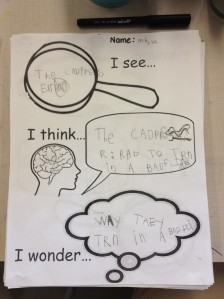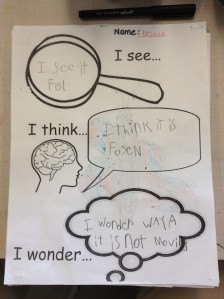Today I thought I’d share a strategy I use to help my students communicate their thinking during the inquiry process. See, Think, Wonder is a thinking routine I use with my students to help them think critically about an object or idea and express their ideas with others. See, Think, Wonder is a strategy that developed out of Harvard’s Project Zero. It was originally developed with a view to help children think critically about art and artwork, though I use it across my program and have found it particularly effective during inquiry projects. If you haven’t checked out the Project Zero website, I highly recommend it! There are a number of amazing strategies and projects there which anyone working with early learners might find useful.
See, Think, Wonder falls under one of Project Zero’s “Thinking Routines.” Basically, the idea of a thinking routine is that you approach it the way you do any other routine you want to establish in your class, with lots of modelling, practice, and a gradual release of responsibility. As a kindergarten teacher, the idea of establishing routines is a familiar one. We have routines for entry, snack time, carpet time, etc. Why not have routines for thinking as well?
When I was thinking about how I would introduce this routine to the class, I knew I wanted to create a visual element to accompany the language prompts as I thought it might help my students connect to what I was talking about. I created the following template using both words and images. For “I See…,” I included an image of a magnifying glass (not just a picture of eyes, as I had originally thought, because I wanted to impart the idea of looking deeply at something); for “I think…,” I included a picture of a brain; for “I wonder…,” I put a picture of a thought cloud (this is specific to my class because I have a bunch of thought clouds on sticks that we use to communicate our “wonderings,” so I knew my students would connect to that and know what I wanted them to express). Here is the finished template I created – you can click on it for a pdf version:
To begin, I use an electronic version of the template on the SmartBoard to model my own thinking. This year, I started by using a photograph from a recent nature walk we went on as a class so that the children would have their own schema for the event that I was talking about. However, you can just as easily use a new image or object. Over the coming days and weeks, I repeat the routine but gradually involve the children’s ideas. I always record our thinking on the same template.
When I feel that the children are comfortable with the template and the language, I place copies of the template at our discovery centre. Here, the children are given an opportunity to communicate their own ideas. Some children draw pictures to show their thinking, and others attempt to write their own ideas down with a combination of letters and familiar words.
Here are a couple examples from our butterfly inquiry last year:
I see the caterpillars eating. I think the caterpillars are ready to turn into a butterfly. I wonder why they turn into a butterfly.
I see it fell. I think it is frozen. I wonder why it is not moving.
What do you think about using See, Think, Wonder as a thinking routine for your class? Are you using any other strategies for encouraging deep thinking with your students?





Thank you so much for this post! It was so timely for me. I also love your template!!
That’s great, Beth! I’m happy you found something helpful!
Alexis
Love this idea! Thanks for sharing!! Do you have a link for your poem?
Thanks so much for sharing this – I have been trying to look for ways to bring more questioning and wonder into my kg classroom. Great ideas! Thanks
Hi
You may want to look into Habits of the Mind. It reminds students what skills we need for learning. It mentions the idea of looking closely which I find very important for my journey into inquiry with the little ones. By using our focusing skills, we are learning how to focus our learning on explorations too! Hope it helps!
Hi Anna Maria! Thanks for the suggestion!
Hi,
I am trying to share and implement this thinking routine with my K class. Could you elaborate a bit more on the difference between think and wonder? Does one flow from another? It seems like the think part could be a hypothesis to answer the wonder… I’m interested to hear more. Some of my students are really responding to this routine as a way to share their thinking.
Cheers,
Hilary
Hi Hillary! Thanks for the question. For me, “think” can be anything from a prediction to a hypothesis to a conclusion/misconception. A wonder is a question the child has about something or something they would like to know more about. In the beginning when we use this routine I find the children’s thinking is often unconnected (no flow from one idea to another). However, as they experience more modeling and practice in conversation you will see their ideas start to flow together.
I hope that you are giving them lots of time to develop their own theories about their inquiries through student collaboration of their ideas. Having them reflect together about their theories is extremely important. And as I was taught when I went to school at the Loris Malaguuzzi centre in Reggio Emilia, children’s theories will change over time and should never be corrected by a teacher, as a misconception.
You are right Jan. We don’t correct misconceptions at this age, those tend to resolve on their own through further exploration or discussion with more knowledgable peers. I used the term only to illustrate that “think” relates to an idea the child believes is something they know whether we know it to be correct or not. In my experience, the children are often pretty firm about what they think but their wonders may develop out of their own uncertainty about what they are observing.
Pingback: The Wonder Window | The Curious Kindergarten
Love this template!! Thank you so much for sharing. 🙂
thanks for sharing!
This is perfect for introducing the NGSS. Thank you.
Pingback: Artifact Journal #1 – Robin Nicholls
First of all thank you very much for such higly inpiring webpage:) I have a question about “I wonder” part. Do you help them to find out answers for their wonders? or What should be the next step for us as teacher to help them to find the answers for their wonders?
Thank you very much:)
Pingback: Week 10 – Technology and Inquiry with Joanna Lake – Rich McCue v5.0